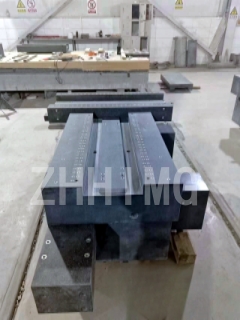Precision granite components and precision ceramic components have different hardness characteristics, and this characteristic difference is directly related to their wear resistance.
In terms of hardness, precision ceramic components are known for their excellent hardness performance, often far superior to precision granite components. Because of its unique material composition, precision ceramics exhibit extremely high hardness levels and can maintain stable physical properties in a variety of environments, which makes it particularly good in high-load, high-wear applications. Precision granite, although it also has a certain hardness, but compared with precision ceramics, it is still slightly inferior.
When it comes to wear resistance, precision ceramics have become the material of choice in many fields due to their high hardness and excellent wear resistance. Its stable structure makes the ceramic surface difficult to be worn, and it can maintain a good performance state even during a long time of use. Precision granite, although also has a certain wear resistance, but in the face of extreme or high strength wear environment, its performance may not be as stable as precision ceramics.
Therefore, from the point of view of hardness and wear resistance, precision ceramic components are in most cases better than precision granite components. However, in practical applications, it is also necessary to comprehensively consider factors such as specific use scenarios, cost budgets and processing requirements to select the most suitable materials. Of course, in addition to hardness and wear resistance, precision granite components and precision ceramic components also have their own characteristics and application advantages in other aspects.
Precision granite components, due to their natural mineral composition and stable physical properties, are often used in situations requiring high precision and stability. For example, in the fields of precision measurement, optical instrumentation and semiconductor manufacturing, granite platforms and plates are widely used for their excellent flatness and low thermal conductivity. In addition, granite also has good corrosion resistance and weather resistance, which can maintain its performance in harsh environments for a long time.
Precision ceramic components, in addition to their excellent hardness and wear resistance, also have excellent high temperature resistance, corrosion resistance and insulation properties. This makes precision ceramics have a wide range of application prospects in aerospace, energy, chemical and other fields. For example, in aircraft engines, precision ceramic components can withstand high temperature and high pressure environments, improving engine efficiency and reliability; In the chemical industry, the corrosion resistance of precision ceramics makes them the preferred material for handling corrosive media.
In addition, with the progress of science and technology and the development of technology, the preparation technology and application field of precision ceramics are also constantly expanding. For example, through advanced ceramic additive manufacturing technology, ceramic parts with complex shapes and high precision can be prepared; The wear resistance, lubrication and biocompatibility of ceramics can be further improved by surface modification technology.
In summary, precision granite components and precision ceramic components have advantages in hardness, wear resistance, high temperature resistance, corrosion resistance and other aspects, and are suitable for different applications. When selecting materials, it is necessary to comprehensively consider factors such as specific use requirements, cost budget and processing capacity to select the most suitable materials.
Post time: Aug-05-2024

